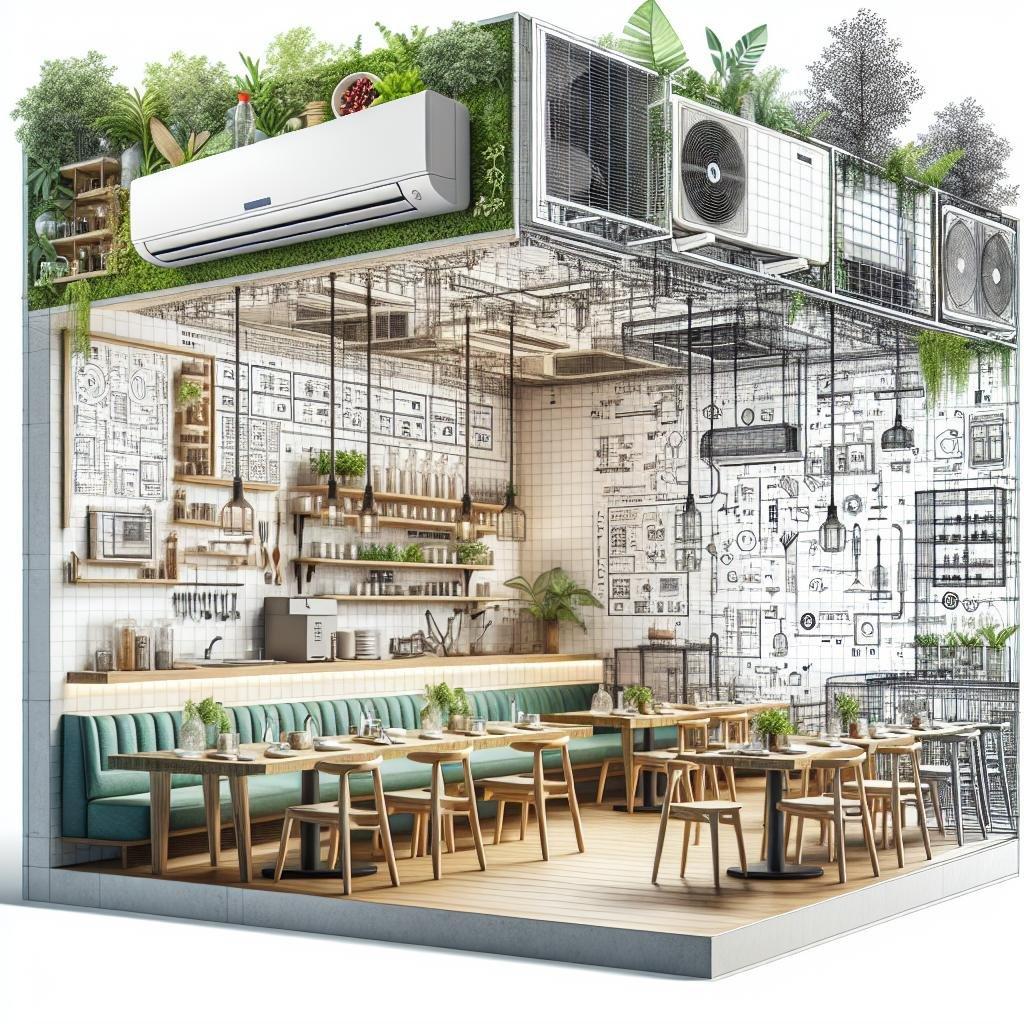As the sizzling grill and clattering dishes create a symphony of culinary delight, the ambiance surrounding them plays a pivotal role in a restaurant’s success. With the evolving trends in dining experiences, restaurateurs are increasingly turning to innovative solutions to enhance the comfort of their patrons. Among these solutions, mini split air conditioning systems are gaining popularity for their energy efficiency and design versatility. Whether you’re embarking on a full-scale renovation or a simple remodel, incorporating mini split AC units not only ensures a cozy atmosphere year-round but also adds an element of modern sophistication. in this article, we explore the best ways to seamlessly integrate these innovative cooling systems into yoru restaurant’s layout, transforming your space into a cool haven for guests while maximizing efficiency and style.
Maximizing Comfort and Efficiency in Dining Spaces
When planning a restaurant renovation, integrating a mini split AC system can considerably enhance both comfort and efficiency. These systems not only provide targeted cooling for specific areas, but they also offer greater energy efficiency compared to customary HVAC setups. By installing units in strategic locations, restaurant owners can ensure that diners experience optimal temperatures, regardless of how crowded the space may become. Here are some innovative ways to incorporate mini splits:
- Zone Cooling: Use multiple mini split units to create different temperature zones,catering to customer preferences and seasonal changes.
- Aesthetically Pleasing Installations: Choose stylish units that blend seamlessly with the restaurant’s decor, maintaining an inviting atmosphere.
- Quiet Operation: Opt for models designed for silent performance, ensuring that the dining experience remains undisturbed by noisy machinery.
Additionally, integrating mini splits into the design can streamline the renovation process. With their compact size, mini splits eliminate the need for extensive ductwork, saving both time and money. This flexibility allows for a more fluid design layout, accommodating features like open kitchens or outdoor dining areas without compromising on air quality. Consider the following factors when planning your installation:
| Factor | Consideration |
|---|---|
| Space Availability | Assess ceiling heights and wall space for optimal unit placement. |
| Electrical Requirements | Ensure adequate electrical supply for multiple units. |
| Maintenance Access | Plan installation with access points for easy servicing. |

Strategic Placement for Optimal Airflow and Aesthetic Appeal
When integrating mini-split AC systems into restaurant spaces, careful attention to placement can significantly enhance both functionality and the overall dining experience. Strategically positioning indoor units in locations that allow for seamless airflow helps to maintain a comfortable environment,ensuring that patrons feel relaxed without being subjected to direct drafts. Consider the following optimal placement strategies:
- Near seating areas: Position units close to frequently occupied tables to ensure comfort.
- Above entry points: Installing units above doors can help in managing incoming heat and maintaining a steady temperature as patrons come and go.
- Hidden installations: Use architectural elements like soffits or ceiling recesses to conceal units, preserving aesthetic integrity while maximizing airflow.
In addition to functionality, aesthetics should not be overlooked. A well-designed mini-split system can either blend into the overall restaurant theme or serve as a statement piece. Here are some creative ways to incorporate the AC seamlessly into your restaurant’s design:
- Color coordination: choose units that match or complement the restaurant’s color scheme, enhancing visual harmony.
- Decorative covers: Invest in custom covers that reflect the restaurant’s style, such as rustic wood slats for a farmhouse theme or sleek metal designs for a modern approach.
- Integrated design: Collaborate with architects to create built-in cabinetry that houses the unit while adding storage or display space.
| Placement Location | Airflow Benefit | Aesthetic Consideration |
|---|---|---|
| Near Seating Areas | Enhances guest comfort | Blends with table arrangements |
| Above Entry Points | Controls incoming hot air | Subtle integration above doorways |
| Behind Decorative Panels | Discreet airflow | Enhances design without clutter |
Integrating Mini Split Systems into Existing Designs
When incorporating mini split systems into your restaurant’s existing design, consider the layout and architecture of your space.Creative placement can maximize both efficiency and aesthetics. Strategically positioning the indoor units in less visible areas, such as high on walls or near the ceiling, can definitely help maintain the visual appeal of your restaurant while ensuring optimal airflow. Additionally, using custom enclosures or wall art to blend the mini splits into the decor can provide a seamless integration while adding a unique touch to the ambiance.
another effective approach is to leverage existing infrastructure to minimize disruption during renovations. Examine the placement of ductwork, lighting fixtures, and other utilities to identify locations where mini splits can be integrated with minimal adjustments. consider the following techniques:
- Using horizontal and vertical units that complement furniture arrangements
- Incorporating design elements like wood or metal framing around the units
- Employing multi-zone systems that allow for targeted heating and cooling in specific areas
By optimizing placement and blending design, you can enhance both functionality and style in your restaurant’s environment.

Long-Term Benefits of Mini Splits in Restaurant Operations
Incorporating mini split air conditioning systems into restaurant renovations not only enhances comfort but also offers meaningful long-term benefits. These systems deliver efficient heating and cooling solutions that cater specifically to the fluctuating demands of restaurant environments. With individual temperature control for different zones, mini splits allow restaurant owners to optimize energy use, ensuring that crucial areas such as kitchens, dining areas, and storage rooms maintain their desired climate without wasting excess energy. This leads to reduced energy costs over time, resulting in a noticeable decrease in operational expenses.
Furthermore, the reliability and low maintenance of mini split systems provide peace of mind in the fast-paced restaurant industry. Unlike traditional HVAC systems, which frequently enough require costly duct repairs and maintenance, mini splits have fewer components and are easier to service. Many models are designed to operate quietly, decreasing noise distractions for both staff and customers. By investing in mini splits, restaurant owners can expect improved indoor air quality, as these units frequently enough come with advanced filtration systems to reduce allergens and pollutants. As a long-term solution,mini splits represent a smart investment,enhancing both the dining experience and operational efficiency.
Q&A
Q&A: Best Ways to incorporate Mini Split AC into Restaurant Renovations and Remodels
Q: What is a mini split AC system, and why is it a good choice for restaurants?
A: A mini split AC system is a type of air conditioning system that consists of an outdoor compressor and one or more indoor air-handling units. They are excellent for restaurants as they offer zone control, enabling you to customize the temperature in different areas, such as kitchens, dining areas, and restrooms. This can lead to increased comfort for patrons and staff while also being energy-efficient.
Q: How can mini split AC systems fit into a restaurant’s interior design?
A: Mini split units come in various styles, including wall-mounted, ceiling-mounted, and ducted options, allowing them to blend seamlessly into any design aesthetic. During renovations, consider placing units strategically to minimize visual impact—behind decorative features or in ceiling recesses—ensuring they complement the overall ambience rather than detract from it.
Q: Are there specific renovations that work well with the installation of mini split AC?
A: absolutely! Open-concept layouts often lend themselves well to mini split installation since these systems can efficiently cool larger spaces. Additionally, when renovating older buildings, mini splits can avoid the need for extensive ductwork, maintaining the character of past structures while providing modern climate control.
Q: What should restaurateurs consider when choosing the location for mini split units?
A: When selecting locations,consider both functionality and aesthetics. Units should be positioned where they won’t obstruct traffic flow but can still effectively distribute cool air, perhaps near seating areas or over food prep zones. Avoid placing units directly above dining tables to minimize noise and ensure a pleasant dining experience.
Q: How can mini split AC systems enhance energy efficiency during restaurant renovations?
A: Mini split systems are inherently more energy-efficient than traditional HVAC systems because they allow for targeted cooling and heating. by installing them during renovations, restaurants can optimize their energy consumption, reducing utility costs and enhancing sustainability—a significant draw for today’s environmentally-conscious customers.
Q: Can mini splits address the heating needs as well?
A: Yes, most mini split systems provide both heating and cooling solutions. This dual functionality makes them an excellent option for year-round comfort, allowing restaurants to maintain a pleasant atmosphere regardless of the season without needing separate systems.
Q: What are some common misconceptions about using mini splits in restaurants?
A: One common misconception is that mini split systems are noisier than traditional HVAC systems. However,many modern units operate at very low noise levels and can be quieter than large central air systems. Another myth is that they are too expensive to install; while the upfront cost can be higher, savings in energy efficiency and future maintenance frequently enough offset this.
Q: How can restaurant owners maximize the benefits of their mini split AC systems during renovations?
A: To maximize benefits, consider integrating smart technology with your mini splits for remote temperature control and scheduling. Additionally, during renovations, focus on proper insulation and seal any air leaks to improve overall efficiency. Regular maintenance checks post-installation also ensure the systems run optimally, maintaining a comfortable environment for guests and employees alike.
Q: Any final tips for restaurant owners planning a renovation with mini split AC in mind?
A: Plan ahead! Collaborate with HVAC professionals to assess your restaurant’s unique needs. Take time to evaluate your layout and customer flow to choose the best mini split options. Remember, incorporating climate control isn’t just about comfort—it’s about enhancing your guests’ dining experience and optimizing your operational efficiency. Happy renovating!
Wrapping Up
As you embark on the journey of renovating or remodeling your restaurant, integrating a mini split AC system can be a game changer. These units not only offer superior energy efficiency but also provide the flexibility needed to create a comfortable dining atmosphere for your patrons. By carefully considering the placement, design, and functionality of your mini splits, you can elevate your space without compromising on aesthetics or comfort.
Incorporating a mini split AC into your renovation plan is more than just a practical decision; it’s a step toward enhancing your customers’ experience and maximizing your establishment’s potential. As you breathe new life into your restaurant, remember to prioritize both style and comfort, ensuring a welcoming retreat for guests year-round. In a competitive culinary landscape, every detail matters, and a well-thought-out HVAC strategy is just one of the many ways to make your restaurant stand out. Here’s to creating a revitalized space that keeps your guests cool, comfortable, and coming back for more!

